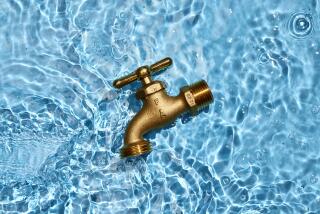Automatic Faucets Get Into the Flow : Conservation: Water Facets of Irvine says its pricey fixtures with infrared sensors are selling well.
SANTA ANA — After three years of using a kitchen faucet that automatically turns on when an object is placed beneath it, Andrea Bertrand sometimes has trouble adjusting to ordinary spigots.
“Now I go to my mother’s home, stick my hand under the tap, and think, ‘What’s the matter with this thing?’ ” Bertrand said.
Bertrand, who manages an escrow company in Santa Ana, bought the automatic faucet for her home to conserve water. The faucet, which uses an infrared sensor to turn water on and off, can save up to 80% of the water of regular faucets, manufacturers claim.
Now that the drought is forcing mandatory cutbacks in some California homes, sales of automatic faucets are flowing faster, according to an Irvine company that claims to be the nation’s only manufacturer of automatic faucets for the home.
Karen Raab co-founded Water Facets in 1989 to sell automatic faucets and sold less than one faucet a day during her first year in business. Now she says she’s selling about three a day--at $840 to $910 apiece.
“I can tell from the phone calls I’m getting that people are more conscious of saving water,” Raab said.
The typical customers are affluent married couples who are remodeling a kitchen or bathrooms, Raab said. Other buyers have included doctors’ offices, art galleries and architects’ studios.
Rita Chemers, owner of Chemers Gallery in Tustin, bought an automatic faucet from Water Facets to “keep up with the modern feel” of the art gallery’s decor.
Water Facets sells the devices through home design centers and over the telephone to customers nationwide, but the faucets are most popular in Southern California. “Californians are leaders; they’re more likely to try new technologies,” Raab said.
Scores of other companies are coming up with water-saving devices. Water-saving shower heads run from several dollars up to about $25. Plumbing supply stores stock low-flow toilets that cost from $90 to $400, and there are numerous gadgets that fit into toilet tanks. But the Metropolitan Water District says the low-tech option seems to work as well as any: Put a quart bottle filled with water and weighted with sand in the tank.
The faucets may make people feel better but they don’t save all that much water, said Matthew Puffer, an MWD analyst. “They’re very expensive,” he said. “So I don’t think you would see a pay-back period very soon because the amount of water a family uses out of the faucet is a very small percentage. You will see a volume savings in commercial applications.”
Raab contends that automatic faucets can save enough water to pay for themselves in anywhere from four months to three years, depending on water usage.
Puffer suggests a less costly way to conserve: Don’t run the water when you’re brushing your teeth or shaving. “Just pay attention to your habits,” he urged.
The largest U.S. manufacturer of sensor-operated bathroom fixtures for commercial use--Sloan Valve Co. in Franklin Park, Ill.--is also noticing an increase in business.
“Business has magnified in the last two years by a couple of hundred percent,” said Tim Ames, product manager.
Sloan Valve has installed the faucets in restrooms at John Wayne Airport and Chicago’s O’Hare Airport, among others, and is putting them in the Citicorp building in Los Angeles. The company also makes urinals and toilets with infrared sensors.
Hygiene is another reason the knob-less, handle-less spigots are catching on, Ames said: “People have a tendency, because of AIDS, not to want to touch the fixtures.”
He said the fear remains despite medical experts’ repeated assurances that the AIDS virus cannot be transmitted through casual contact.
Raab and a friend, Alan Rosenberg, started the company in the spring of 1989 while they were studying for MBA degrees at UC Irvine. Rosenberg got the idea for the business after noticing automatic faucets in a men’s restroom at a Florida airport. The two started the company with $150,000 of personal savings. Rosenberg has since moved to South America to run a family business.
Now, Raab is trying to raise $1 million from investors to develop a less-expensive automatic faucet that would retail for $300 to $400 and have fewer special features.
“There’s a large mid-range market we miss because of the expense,” she said.
More to Read
Inside the business of entertainment
The Wide Shot brings you news, analysis and insights on everything from streaming wars to production — and what it all means for the future.
You may occasionally receive promotional content from the Los Angeles Times.










